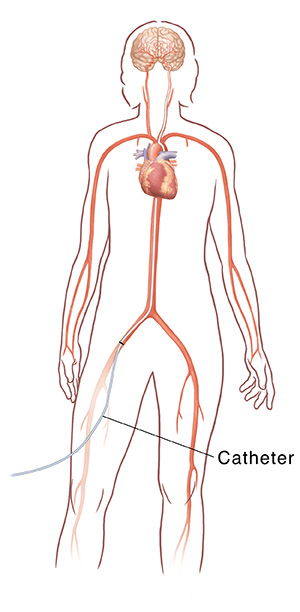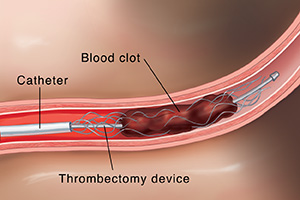Mechanical thrombectomy is a procedure used to remove a blood clot in an artery. It’s most often used as an emergency treatment for some ischemic strokes. This is when a blood clot is blocking blood flow to the brain. Mechanical thrombectomy is a type of reperfusion therapy, which means restoring blood flow. This treatment is only done at special stroke centers. It should be done within 6 hours of the first symptoms of stroke or, in some people, up to 24 hours.
Why the procedure is done
Mechanical thrombectomy is done to treat an ischemic stroke in people who have a blockage in a large artery. It can also be used for deep vein thrombosis. This is a blood clot in the legs or arms.
How the procedure is done
Mechanical thrombectomy is done by an interventional radiologist. This health care provider uses medical imaging to do minimally invasive procedures.
For this procedure, you will have general anesthesia. This will put you into a deep sleep-like state. Or you will have sedating anesthesia to make you relaxed and sleepy.
Using a continuous X-ray (fluoroscopy), the provider guides a special tube (catheter) through a blood vessel. This is usually in the groin. The provider moves the catheter to the area of the blood clot. The clot is then removed with a clot-removing device (thrombectomy device) at the tip of the catheter. The clot can also be removed by a catheter that uses suction (aspiration) to remove the clot.
This procedure can be done even if you have been given clot-busting medicines such as alteplase or tPA.
After the procedure
After the treatment, you’ll need to stay in the hospital for at least several days. More imaging tests will be done to check how well the clot is dissolving. Other tests may also be done to help find what caused the stroke.
You will be taken to a recovery area to lie flat for a few hours. Your care team will closely watch your heart rate, blood pressure, breathing, and nervous system status. Your health care provider will discuss the results with you soon after the procedure. Depending on your test results and your health condition, you will either be sent home or stay in the hospital.
After you are home:
-
Don’t drive for 24 hours, or as advised by your provider.
-
Don't walk, bend, lift, or take stairs for 24 hours, or as advised by your provider.
-
Don't lift anything over 5 pounds (2.27 kg) for 7 days.
Follow any other instructions from your provider.
Risks of the procedure
Possible risks of this procedure include:
-
Damage to the artery.
-
Bleeding in or around the brain.
-
Bleeding at the site where the catheter is inserted.
-
Breaking up the clot and having pieces travel to another artery.
-
Blood vessel spasm.
-
Stroke.
-
Death.
When to contact your doctor
Contact your doctor right away if you have any of these:
-
Swelling or pain that gets worse
-
Weakness or numbness near the area of your surgery
-
Bleeding from the incision or other places
-
Fever
-
Symptoms of a blood clot, including swelling, pain, warmth, and redness
-
Shortness of breath or trouble breathing
-
Chest pain



